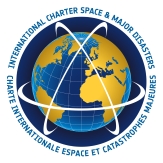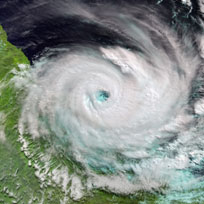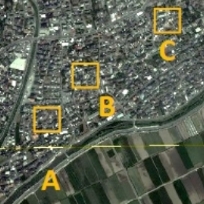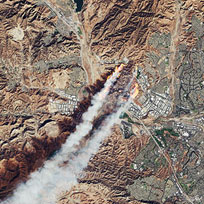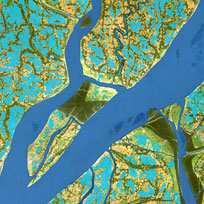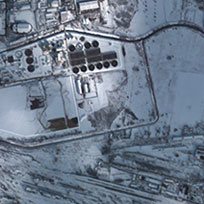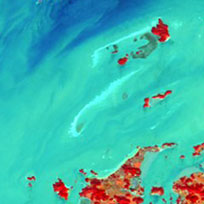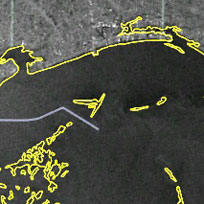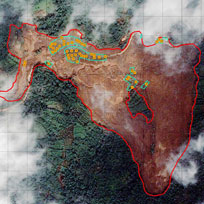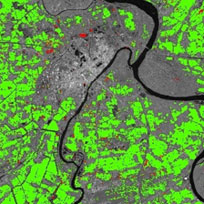How the Charter Works
This illustration depicts the sequence of events that occur once the Charter is activated. Beginning with the authorised user (bottom left), follow the sequence in a clockwise rotation for a brief description of each step.
An activation starts with an Authorised User (AU) - typically a representative of a national civil protection, rescue, or security organisation - who may log in to the Charter Operational System and submit a request to mobilise the space and associated ground resources associated with the Charter members in order to obtain data and information on a major disaster. AU's are the only bodies authorised to directly request an activation of the Charter. They may also request support on behalf of another user with which they co-operate for relief purposes.
In some circumstances, Co-operating Bodies - organisations with which the Charter members are associated - may also request data in the event of a disaster.
A 24-hour On-Duty Operator then receives the request, checks the identity of the requestor and verifies that the User Request Form that has been submitted by the Authorised User, is correctly completed.
The operator passes the information to an Emergency On-Call Officer (ECO) - who also covers a 24-hour shift - within an hour and the ECO analyses the request and the scope of the disaster from the Authorised User. The ECO then prepares an archive and acquisition plan using available satellite resources, planning out what would be the best satellites to use based on the AU's request. This plan is submitted to the relevant space agency, who task their satellite accordingly if it is possible to meet the request.
Data acquisition and delivery takes place on an emergency basis, and a Project Manager (PM), who is qualified in data ordering, handling and application, is assigned by the Executive Secretariat to assist the Authorised User throughout the process. The Project Manager receives a dossier gathered by the ECO, which describes the disaster and what has been carried out for the activation before the PM's nomination.
The Project Manager coordinates the delivery of maps from the Value Added Providers to the end user and co-operating bodies as appropriate. The Value Added Providers take the data provided by member agencies and interpret this, assessing what they see from the satellites and compiling it into value added products - maps created from the data and any ground verification and reports that the Value Added Provider may conduct.
When the activation is closed - typically within several weeks, depending on the scale of the disaster - the PM compiles a report on the activity, which includes any feedback from the end-user, and the Executive Secretariat use these reports to help the continuing evolution of the Charter.
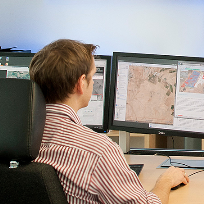
How to become a user
Learn about how to participate in the Charter as an Authorised User through the principle of Universal Access, granting national disaster management authorities the ability to submit a request for activation.
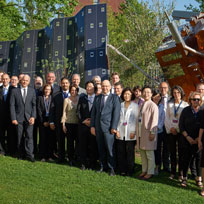
Membership History
Learn about the history of the Charter and the milestone dates when our member agencies joined.
In addition to directly submitting a request to the Charter, other mechanisms are also supported.
Via the UN for UN users
The Charter has an agreement with UNOOSA (Vienna) and UNITAR/UNOSAT (Geneva) to provide support to UN agencies. UNOOSA and UNITAR/UNOSAT may submit requests on behalf of users from the United Nations.
Activation for Asia Pacific users via Sentinel Asia's partner, the Asian Disaster Reduction Centre
Sentinel Asia is a regional collaboration for Earth observation based emergency response in 31 Asia Pacific countries.
Since 2009 the Charter has granted the Asian Disaster Reduction Centre the right to submit activation requests on behalf of national users of Sentinel Asia.
Further actions to improve Charter access with GEO
In response to a request from the Group on Earth Observation (GEO) to improve access to the Charter during emergencies, collaboration has started with primary focus on users from African countries that do not have a direct access to the Charter. In 2009, the Charter initiated a formal user consultation to address the improvement of Charter access in African countries.
New users without direct access to the Charter should address emergency related enquiries to:
executivesecretariat@disasterscharter.org
General enquiries concerning the Charter operations and provisions should be addressed to:
 Authorised Users (AU)
Authorised Users (AU)
- Bodies authorised to request the services of the Charter
- Typically national civil protection, rescue, defense and security bodies
- Recognised as Charter Associated Bodies
 On-Duty Operator (ODO)
On-Duty Operator (ODO)
- Available 24h/day, 7 days/week
- Receives calls requesting space data images and information
- Identifies the caller as being a registered AU
- Obtains and confirms with the AU the information required
- Transmits the information to the ECO (including the AU's contact details)
- Contacts the ECO within an hour of receiving a call
 Emergency On-Call Officer (ECO)
Emergency On-Call Officer (ECO)
- Available 24h/day, 7 days/week
- A shared responsibility of the Charter Members on a rotating weekly basis
- Processes the information received from the ODO
- Verifies the validity of the disaster relief data request
- Identifies the most timely and appropriate satellite resource and prepares a draft plan
- Gets the AU's approval
- AAP (Archives / Acquisition plan)
- Submits request for new images or archives
- Gathers all relevant information in a dossier
- Transfers the dossier to the Project Manager
- Informs Space Agencies of the status of their space resources
 Charter Member order desks
Charter Member order desks
- Plan acquisitions according to requests submitted by ECO
- Resolve any conflicts and suggest alternate acquisitions if necessary
- Program their respective space resources (satellites) to acquire the requested data over the area affected by the disaster. This is dependent on the ability of the satellites to acquire the relevant data.
 Project Manager (PM)
Project Manager (PM)
- Appointed by the Executive Secretariat when the Charter is activated
- Available during normal working hours
- Ensures data is sent to the end user
- Confirms accuracy of data sent to user
- Able to interpret the data
- Coordinates, when required, the delivery of value-added products and information
- Completes dossier with a report submitted to the Executive Secretariat when the activation is closed
 Value Added Provider (VAP)
Value Added Provider (VAP)
- Once the data is acquired, it is processed into images
- The VAP further processes and interprets the data acquired over the disaster area and delivers the images to the End User

 English
English Spanish
Spanish French
French Chinese
Chinese Russian
Russian Portuguese
Portuguese
